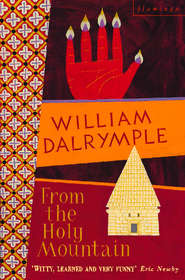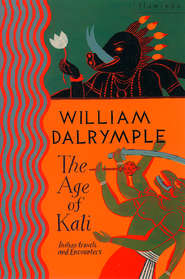По всем вопросам обращайтесь на: info@litportal.ru
(©) 2003-2024.
✖
City of Djinns
Автор
Год написания книги
2019
Настройки чтения
Размер шрифта
Высота строк
Поля
In due course, as the slow wheels of bureaucracy turned, my application did get processed—but not until about a year after the newspaper I represented had ceased publication. Undaunted, to this day Shastri Bhavan still refuses to acknowledge the downfall of the Sunday Correspondent, and continues to send its India representative daily press releases detailing the reasons for the decline in the production of Indian pig iron, or celebrating the success of the Fifth International Conference on the Goat (theme: The Goat in Rural Prosperity).
More depressing even than Shastri Bhavan is the headquarters of Mahanagar Telephone Nigam Limited. The Telephone Nigam is India’s sole supplier of telecommunications to the outside world. Without the help of the Telephone Nigam one is stranded. This is something every person who works for the organization knows; and around this certainty has been built an empire dedicated to bureaucratic obfuscation, the perpetration of difficulty, the collection of bribes and, perhaps more than anything else, the spinning of great glistening cocoons of red tape.
It was a hot, dusty late September morning when I first entered room 311, home to Mr Ram Lal. Mr Lal was sitting beneath a poster of Mahatma Gandhi on which was written: ‘A customer is the most important visitor to our premises. He is not dependent on us, we are dependent on him.’
As if in deliberate subversion of the Mahatma’s message, Mr Lal held in his hands the Times of India, open at its sports page. The paper formed a barrier between Mr Lal and the asylumful of supplicants who were bobbing up and down in front of him, holding out chits of paper, arching their hands in a gesture of namaste or wobbling their turbans from side to side in mute frustration. A Punjabi lady sat weeping in a corner, repeating over and over again: ‘But I have a letter from the Minister of State for Communications … but I have a letter … a letter …’ Menials passed silently to and fro through the door, carrying files and sheaves of xeroxes. Behind Mr Lal, placed there for apparently purely decorative purposes, sat a dead computer.
When Mr Lal eventually deigned to lower his paper—which he did with infinite slowness, folding it into perfect quarters—he rang a bell and ordered one of his peons to bring him a cup of tea.
‘Right,’ he said, looking up for the first time. ‘Who’s first?’
A hundred hands were raised, but one voice stood out: ‘I am.’
The speaker pushed himself forward, holding together his bulging dhoti with one hand. He was an enormously fat man, perhaps seventy years old, with heavy plastic glasses and grey stubble on his chin.
‘My name is Sunil Gupta—please call me Sunny.’ He strode forward and grabbed Mr Lal by the hand, shaking it with great verve.
‘I am a nationalist,’ said Mr Gupta. ‘A nationalist and a freedom fighter. I am also an independent candidate in the forthcoming municipal elections. My election office will be opposite Western Court, adjacent to the paan shop. I want a temporary telephone connection, and would be most grateful if you could expedite.’ He stroked his belly. ‘Early action would be highly appreciated.’
‘Have you already applied for a connection?’ asked Mr Lal.
‘No, gentleman,’ said Sunny Gupta. ‘This is what I am doing now.’
‘First applications Room 101. Next, please.’
‘But,’ said Mr Gupta. ‘I have to maintain contact with my constituents. I need a phone immediately. I would be very grateful if you would expedite a VVIP connection without delay.’
‘Are you a member of the Lok Sabha?’
‘No. I …’
‘In that case you must contact Mr Dharam Vir …’
‘Gentleman, please listen …’
‘… in Room 101.’
With a great flourish, Mr Gupta pulled a much-pawed piece of paper from his waistcoat pocket. ‘Gentleman,’ he said. ‘Please be looking here. This is my manifesto.’
Across the top of the piece of paper, in huge red letters, was blazoned the slogan: A NATIONALIST TO THE CORE AND A FREEDOM FIGHTER. Mr Gupta straightened his glasses and read from the charter:
‘I was a Founder Member cum Chairman of the Religious and Social Institute of India, Patna Branch …’
Mr Lal was meanwhile studying the application of the weeping Punjabi lady. He read it twice and, frowning, initialled it at the top right-hand corner: ‘See Mr Sharma for countersignature. Room 407.’
The woman broke down in a convulsion of grateful sobs. Beside her Mr Gupta was still in full flood:
‘… I am ex-member of the Publicity Committee of the All-India Congress I, Bhagalpur division. Ex-Joint Secretary of the Youth Congress Committee, Chote Nagpur, Bihar. I am a poet and a journalist. A war hero from the 1965 Indo-Pak war, Jaisalmer sector …’
‘Madam,’ continued Mr Lal. ‘Please make payment with Mr Surwinder Singh, accounts, Room 521.’
‘… I was the founder editor of Sari, the Hindi monthly for women and Kalidasa, the biannual literary journal of Patna. I have donated five acres of land for the Chote Nagpur Cow Hospital. Four times I have been jailed by the Britishers for services to Mother Bharat.’
‘If you think it is bad now,’ said Mr Lal, taking my application. ‘You should see this office on Fridays. That’s the busiest time.’
I left Mr Lal’s office at noon. By four-thirty I had queued inside a total of nine different offices, waiting in each for the magic letter, seal, signature, counter-signature, demand note, restoration order or receipt which would, at some stage in the far distant future, lead to my being granted a telephone.
‘Phone will be connected within two months,’ said Mr Lal as he shook my hand, the obstacle course completed. ‘Two months no problem. Or maybe little longer. Backlog is there.’
Mr Gupta was still sitting at the back of Mr Lal’s office. He was quiet now, though still tightly clutching at his election manifesto. I gave him a sympathetic wave as I left.
‘To think,’ he said, ‘that I was in British prison seven times with Gandhiji for this.’
At his desk, Mr Lal had returned to the sports page of the Times of India.
Although parts of the city still preserved the ways of the Mughal period or even the early Middle Ages, Delhi was nevertheless changing, and changing fast.
Mr Gupta’s world—the cosy world of the Freedom Struggle, of homespun Congress Socialism and the Non-aligned Movement—all of it was going down; driving around New Delhi you could almost feel the old order crumbling as you watched, disappearing under a deluge of Japanese-designed Maruti cars, concrete shopping plazas and high-rise buildings. Satellite dishes now outnumber the domes of the mosques and the spires of the temples. There was suddenly a lot of money about: no longer did the rich go up to Simla for the summer; they closed their apartments and headed off to London or New York.
The most visible change was in the buildings. When I first saw Delhi it was still a low-rise colonial capital, dominated by long avenues of white plaster Lutyens bungalows. The bungalows gave New Delhi its character: shady avenues of jamun and ashupal trees, low red-brick walls gave on to hundreds of rambling white colonial houses with their broken pediments and tall Ionic pillars.
One of my strongest memories from my first visit was sitting in the garden of one of the bungalows, a glass to hand, with my legs raised up on a Bombay Fornicator (one of those wickerwork planter’s chairs with extended arms, essential to every colonial veranda). In front lay a lawn dotted with croquet hoops; behind, the white bow-front of one of this century’s most inspired residential designs. Over the rooftops there was not a skyscraper to be seen. Yet I was not in some leafy suburb, but in the very centre of New Delhi. Its low-rise townscape was then unique among modern capitals, a last surviving reminder of the town planning of a more elegant age.
Now, perhaps inevitably, it was gradually being destroyed: new structures were fast replacing the bungalows; huge Legoland blocks were going up on all the arterial roads radiating from Connaught Circus. The seventeenth-century salmon-pink observatory of Rajah Man Singh—the Jantar Mantar—lay dwarfed by the surrounding high-rise towers that seemed purpose-built to obscure its view of the heavens. Over the great ceremonial way which led from Lutyens’s Viceroy’s House to India Gate now towered a hideous glass and plastic greenhouse called the Meridien Hotel.
Other, still more unsympathetic blocks were already planned. On Kasturba Gandhi Marg (originally Curzon Road) only two of the old Italianate villas still survived, and one of these was in severe disrepair. Its plaster was peeling and its garden lay untended and overgrown. In front of its gate stood a huge sign:
A PROJECT FROM THE HOUSE OF EROS
ULTRAMODERN DELUXE MULTISTOREYED
RESIDENCE APTS.
COMPLETION DATE 1994.
It was said that not one private Lutyens bungalow would survive undemolished by the turn of the century.
There were other changes, too. The damburst of western goods and ideas that were now pouring into India had brought with them an undertow of western morality. Adulterous couples now filled the public gardens; condom advertisements dominated the Delhi skyline. The Indian capital, once the last bastion of the chaperoned virgin, the double-locked bedroom and the arranged marriage, was slowly filling with lovers: whispering, blushing, occasionally holding hands, they loitered beneath flowering trees like figures from a miniature. Delhi was starting to unbutton. After the long Victorian twilight, the sari was beginning to slip.
Other changes in the city were less promising. The roads were becoming clogged; pollution was terrible. Every day the sluggish waters of the Jumna were spiced with some 350 million gallons of raw sewage.
Alongside the rapidly growing wealth of the middle class, there was also a great increase in poverty. Every week, it was said, six thousand penniless migrants poured into Delhi looking for work. You could see them at the traffic lights along Lodhi Road, hands outreached for alms. The jhuggis— the vast sackcloth cities in which these people lived—had quadrupled in size since 1984. New jhuggi outposts were spreading along the dry drainage ditches, filling the flyovers, sending tentacles up the pavements and the hard shoulders. At night, cooking fires could be seen flickering inside the old Lodhi tombs.
Attitudes were changing too. A subtle hardening seemed to have taken place. In the smart drawing-rooms of Delhi, from where the fate of India’s 880 million people was controlled, the middle class seemed to be growing less tolerant; the great Hindu qualities of assimilation and acceptance were no longer highly prized. A mild form of fascism was in fashion: educated people would tell you that it was about time those bloody Muslims were disciplined—that they had been pampered and appeased by the Congress Party for too long, that they were filthy and fanatical, that they bred like rabbits. They should all be put behind bars, hostesses would tell you as they poured you a glass of imported whisky; expulsion was too good for them.
Strangely, in these drawing-rooms, you never heard anyone complain about the Sikhs. But of course it was they and not the Muslims who had most recently suffered the backlash of this hardening, this new intolerance which, like an unstable lump of phosphorus, could quite suddenly burst into flames.
TWO (#ulink_24b6ead4-2b8e-529a-bf78-cbb80e8e6ce7)







